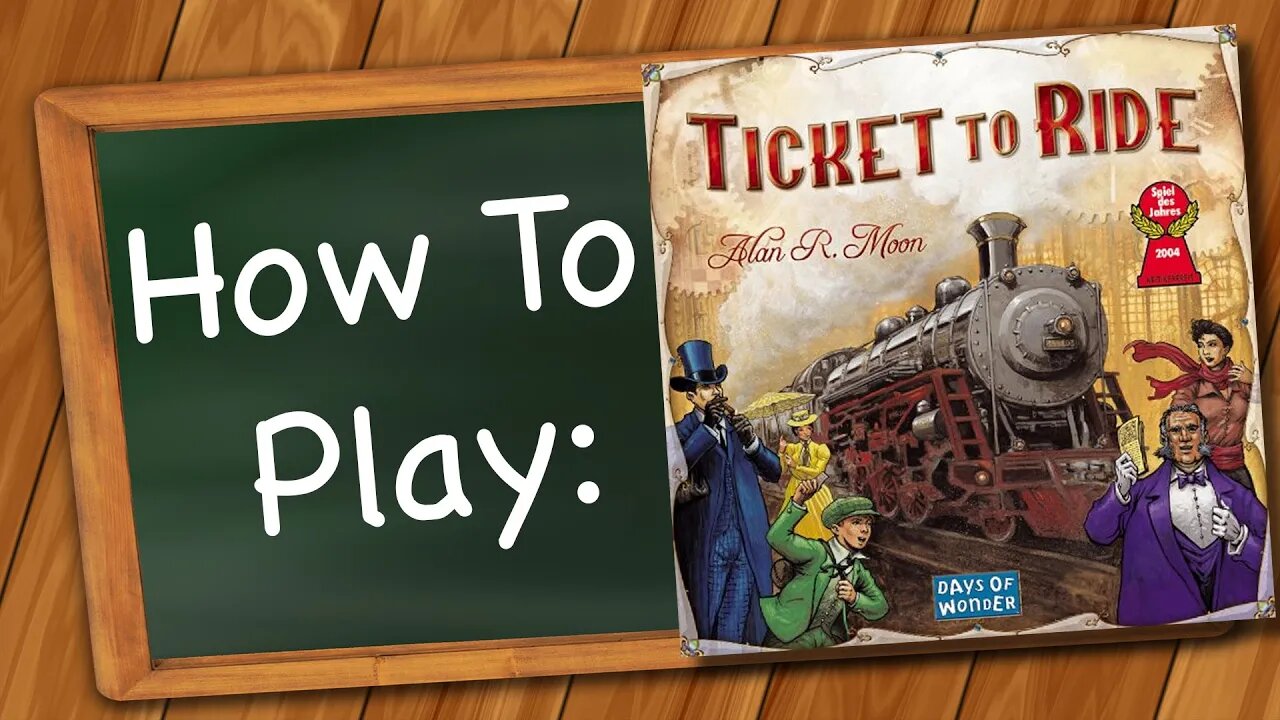Premium Only Content

How to Play Ticket to Ride
Learn the rules to the board game Ticket to Ride quickly and concisely - This visually rich video has no distractions, just the rules.
Don't own the game? Buy it here:
USA - https://amzn.to/3bi8BYs
Canada - https://amzn.to/2X4Pv5A
UK - https://amzn.to/3jYnsha
Australia - https://amzn.to/3984Y85
(These Amazon Affiliate links directly supports me)
RULES:
The object of the game is to have the most points at the end of the game. You receive points three ways: Every time you place trains on the board and connect two cities, by completing destination cards, and by having the longest continuous train. You lose points for uncompleted destination cards.
Setup: layout the board and each player chooses a color. Place each players point tracking token in the corner next to the 1. Shuffle the train cards and deal 4 cards to each player. Place the deck on the table and turn over the top 5 cards face up on the table. Shuffle the destination cards and deal 3 to each player. Each player may discard one of those if they like. Any returned destination cards are placed at the bottom of the destination deck. Destination cards remain hidden from your opponents until the end of the game.
The person with the most travel experience goes first.
On your turn you perform 1 of three actions: Draw 2 train cards, Claim a route, or Draw destination tickets. If you draw train cards you may draw from the face up cards or the top of the deck, or one of each. There is no limit to the amount of cards a player can hold in his hand. When you draw a face up card, the top card of the deck immediately replaces the drawn card. If the draw deck runs out, shuffle the discard into a new draw deck.
Locomotives are wild cards, and if there is one face up, it can only be drawn if you haven’t drawn any other train cards this turn (it takes two draws to draw 1 face up locomotive). If your first draw was from the top of the draw deck and it was a locomotive, you are allowed to draw again. Whenever there are three face up locomotives, discard all 5 face up cards and flip 5 new ones over.
To claim a route you must play a colored set of train cards from your hand equal to the color and quantity of the route you wish to claim. Then place your colored train pieces on the board thus claiming your route. You may not mix card colors unless it is a locomotive, and you may not partially claim a route if you don’t have enough cards. Once you claim a route, it is permanently yours for the rest of the game.
If the route color is gray, then you are allowed to use any of one color to claim that route. If there are two paths next to each other, known as a double route, a single player may only claim one side. If you are playing with 2 or 3 players treat double routes as if they were single routes.
Each time you claim a route you gain points based on how long the route you claimed is. If the route is 1 train long you receive 1 point. If the route is 2 trains long you receive 2 points. 3 trains is worth 4 points. 4 is worth 7, 5 is 10, and 6 is 15. Each time you claim a route move your point tracker up the corresponding points.
Destination cards give or take away points at the end of the game as indicated by the number on the card. Add points to your score if you successfully connected the specified routes on your destination card. The path does not need to be the most efficient for it to count. For example if your destination said to get from Kansas City to Houston and you did this, you would still receive 5 points for making the route even though it wasn’t the most efficient. However, if you didn’t make the route, no matter how close you came, you receive negative points instead.
Once one player has 0, 1, or 2 trains left at the end of his turn, then each player, including that player, gets one final turn. Then the games ends and players calculate their score. You may re-count scores if necessary. Add or subtract the appropriate destination points. Finally, assign the player who has the longest continuous path a bonus of 10 points. If multiple players are tied for longest continuous path, then all tied players each receive 10 points.
Tally up all the points and the player with the most points wins. If there is a tie, then the player who completed more destination tickets wins. Still a tie, then the player who had the longer continuous path wins.
-
 0:32
0:32
Triple S Games
1 year ago $0.01 earnedThe Free Castling Rule
303 -
 14:53
14:53
Forrest Galante
1 hour agoAustralia's Top 5 Deadliest Animals
3.34K1 -
 LIVE
LIVE
DLDAfterDark
1 hour agoDLD Live! What's The "best" PDW?? Considerations For Trunk/Truck Gun & Gats in Bags & Backpacks
214 watching -
 15:25
15:25
Exploring With Nug
12 hours ago $1.30 earnedBag of Phones Found While Searching For Missing Man In River!
50.9K19 -
 LIVE
LIVE
fuzzypickles168
2 hours agoLate Nite Jam Session - Rock Band 4 | Was: EA Sports WRC | 1 John 2:1-17
46 watching -
![Nintendo Switch It UP Saturdays with The Fellas: LIVE - Episode #13 [Mario Kart 8 Deluxe]](https://1a-1791.com/video/fww1/97/s8/1/1/g/A/z/1gAzy.0kob-small-Nintendo-Switch-It-UP-Satur.jpg) 3:33:38
3:33:38
MoFio23!
11 hours agoNintendo Switch It UP Saturdays with The Fellas: LIVE - Episode #13 [Mario Kart 8 Deluxe]
18.9K -
 23:24
23:24
MYLUNCHBREAK CHANNEL PAGE
12 hours agoDams Destroyed Turkey
72.6K62 -
 LIVE
LIVE
SpartanTheDogg
4 hours agoPro Halo Player
169 watching -
 11:29
11:29
Tundra Tactical
4 hours ago $0.28 earnedGEN Z Brit 3D Prints a WORKING Gun Pt.3!
33.6K3 -
 LIVE
LIVE
AdmiralSmoothrod
6 hours agoark ascended - its dino time again
150 watching